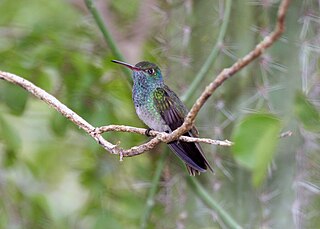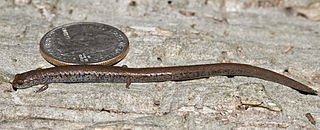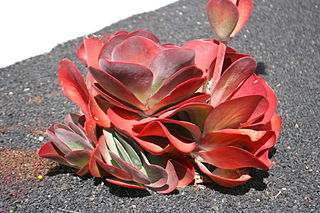
Megalomys luciae, also known as the Saint Lucia pilorie or Saint Lucia giant rice-rat, as well as several variant spellings, is an extinct rodent that lived on the island of Saint Lucia in the eastern Caribbean.

The Honduran emerald is a Vulnerable species of hummingbird in the "emeralds" tribe, Trochilini, of the subfamily Trochilinae. It is endemic to Honduras.

The Santa Lucia Mountains slender salamander is a species of salamander in the family Plethodontidae. It is endemic to California in the United States, where it is known only from Monterey County.

Diadumene lineata, the orange-striped green sea anemone, has several morphotypes which have been described multiple times.

Anolis luciae, also known commonly as the St. Lucia anole or Saint Lucian anole, is a species of anole lizard in the family Dactyloidae. The species is endemic to Saint Lucia, an island-nation in the Caribbean Lesser Antilles.

Conus luciae is a species of sea snail, a marine gastropod mollusk in the family Conidae, the cone snails and their allies.

Parmenini is a tribe of longhorn beetles of the subfamily Lamiinae.

Fundulus luciae, the spotfin killifish, is a member of the genus Fundulus. This hardy fish is notable for spending its entire life in sporadically flooded salt marsh habitat, sheltering in shallow pools, puddles, and small tidal rivulets. It closely resembles the mummichog in shape and coloration, but the two species can be distinguished by dorsal fin ray count: 8–9 in the spotfin versus 11–12 in the mummichog. Additionally, the dorsal fin of F. luciae originates farther back, and slightly behind the anal fin origin; in the mummichog, the dorsal fin begins anteriorly to the anal fin origin. The spotfin killifish is named for the pronounced ocellus found on the posterior dorsal fin of adult males. It is a small fish, seldom attaining 50 millimetres (2.0 in) in total length. Its distribution extends along the U.S. east coast from Massachusetts to Georgia.

Athemistus is a genus of longhorn beetles of the subfamily Lamiinae, containing the following species:
Athemistus murina is a species of beetle in the family Cerambycidae. It was described by Stephan von Breuning in 1940.
Athemistus approximates is a species of beetle in the family Cerambycidae. It was described by Carter in 1926. It is known from Australia.
Athemistus barretti is a species of beetle in the family Cerambycidae. It was described by Carter in 1926. It is known from Australia.
Athemistus harrisoni is a species of beetle in the family Cerambycidae. It was described by Carter in 1926. It is known from Australia.
Athemistus laevicollis is a species of beetle in the family Cerambycidae. It was described by Carter in 1926. It is known from Australia.
Athemistus tricolor is a species of beetle in the family Cerambycidae. It was described by Carter in 1926. It is known from Australia.
Athemistus armitagei is a species of beetle in the family Cerambycidae. It was described by Francis Polkinghorne Pascoe in 1866. It is known from Australia.
Athemistus pubescens is a species of beetle in the family Cerambycidae. It was described by Francis Polkinghorne Pascoe in 1862. It is known from Australia.

Athemistus rugulosus is a species of beetle in the family Cerambycidae. It was described by Félix Édouard Guérin-Méneville in 1831. It is known from Australia.
Athemistus conifer is a species of beetle in the family Cerambycidae. It was described by Per Olof Christopher Aurivillius in 1917 and is known from Australia.

Kalanchoe luciae, the paddle plant or flapjacks, is a species of flowering plant in the genus Kalanchoe, native to northeast South Africa, Eswatini, Mozambique and Zimbabwe. It has gained the Royal Horticultural Society's Award of Garden Merit.








